RebLaw workshops: a morning focused on prison reform and housing
WORKSHOP 1: ‘TOUGH ON CRIME? EVIDENCE-BASED APPROACHES TO PRISON REFORM’
Speakers:
- Dr Laura Janes – Howard League for Penal Reform (campaign)
- Rebecca Roberts – INQUEST (campaign
- Jane Ryan – Bhatt Murphy (solicitors)
Dr Laura Janes – Prison doesn’t work
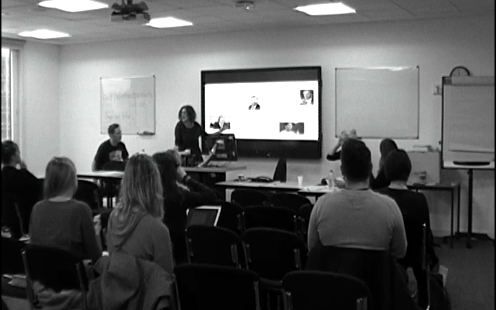
Dr Janes, fresh from her Keynote, started off the session to a smallish group of around 20-30 people. She began by showing us a slide of quotes from various politicians (ie Boris, Blair, Priti Patel) ‘talking tough on crime’. The prison population has doubled since the 1980’s, while at the same time crime has increased in almost the same proportion. Dr Janes pointed out that if sending people to prison decreased crime, the reverse trend should be happening. Around 46% of prisoners will re-offend within a year after release, demonstrating that the prison system does not prevent re-offending. Dr Janes put up an Age-Crime graph on the projector showing that people tend to grow out of crime, the peak of criminality being at around 17 years old, and diminishing thereafter (except for a little peak for the late-30’s, early-40’s!). Thus, the evidence-based approach says that the best option in terms of punishing crime is to do nothing.
The UK continues to have an ‘enduring crisis on safety and decency’ in its prisons. The safety statistics for children in prison was especially alarming. The records numbers sent to prison is a ‘policy by press notice’, with no clear vision for the future. Dr Janes stated that the impact of incarceration is not sufficiently researched, but anecdotally, it is ’really harmful’. The impact of prison on ex-prisoners comes back in the form of recurring nightmares, flashbacks, trauma and psychological harm.

Dr Janes showed a graph of the declining prison population in Finland, so that in 2018 there were just 2,842 people in prison, out of a population of 5.5 million. She said these reductions were a result of changes to the penal code, and it showed that not sending people to prison was both possible and beneficial.
Dr Janes also addressed the question of additional days handed out to prisoners for infractions of prison rules, more often minor, such as having contraband, than violent. An extra thousand years of additional days were handed out each year between 2011 and 2018. At the same time violence in prisons has increased. In Scotland, it was found that additional days had no positive impact on prisoner behaviour.
Jane Ryan – Prison conditions are poor
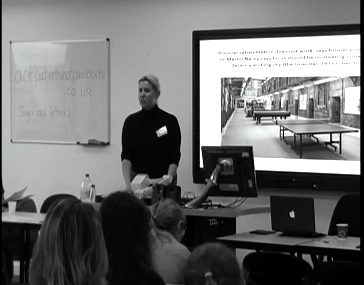
Ms Ryan started with a quote from Sir Martin Narey, ex-Director General of the Prison Service, where he states that bad prisons cause harm. Poor prison conditions can be a breach of Article 3 rights protecting citizens from inhumane and degrading treatment. The Urgent Notification Process can be used where prison conditions are particularly bad. Despite there being many prisons with poor conditions, there are few legal challenges.
There have been ECHR cases on overcrowding in Turkish prisons and a finding of a violation of Article 3 regarding the psychological harm caused in a French prison. The case of Ahmed v UK (2012) 56 EHRR dealt with a ’23-hour bang up’ as a result of a lack of resources to staff the prison properly. Litigation has assisted in improving conditions, such as the ‘stepping out’ litigation which resulted in ablutions being provided in cells, whereas before there had been none. However, recent cases like R(AB) v Secretary of State for Justice [2019] EWCA Civ 9 demonstrates that the law offers only limited protection for the substantive rights of prisoners, instead ‘the courts preferring to defer to the State’. However, litigation is still happening. Ms Ryan provided an example of a case she recently worked on regarding an elderly gentleman who was convicted with a civil law offence (non-payment of council tax) and incarcerated at Wormwood Scrubs prison. The prisoner was locked in his cell all day, trapped in there with rats, and had to go to the toilet in front of his two cell-mates. He sued the Ministry of Justice for PTSD resulting from his experience in prison.
Despite these bad conditions, prisoners are serving ever longer sentences. Take the recent scandal regarding IPP (Imprisonment for Public Protection) sentences, the best known case of its abuse being that of James [2009] UKHL 22. Ms Ryan provided an example of a prisoner she represented, who had been convicted for an attempted handbag theft. As a result of her drug addiction, history of self-harm, etc., Ms Ryan’s client was deemed a ‘classic IPP offender’, and therefore what started out as a 2 year sentence turned into 11 years!
One of the greatest catalysts for penal reform has been prisoners themselves. Ms Ryan put up a photo from the ‘Strangeways Riots’, which lead to a prison inquiry and The Woolf Report. The riots brought about improvements in procedural fairness, a complaints process through an ombudsman and better prison conditions. This prisoner activism (or desperation?) is still continuing, with six ‘significant’ prison disturbances due to poor conditions in recent years, often not reported in the media. Frontline staff in prisons have been cut, and there are a diminishing number of serving prison officers with experience, the results of privatisation and contracting out.
Ms Ryan outlined a number of reforms she would like to see in the prison system: fewer going to prison, accommodation on release, investment in prison education, more releases on temporary licence, and no pregnant women in prison.
Rebecca Roberts – Prison Abolition
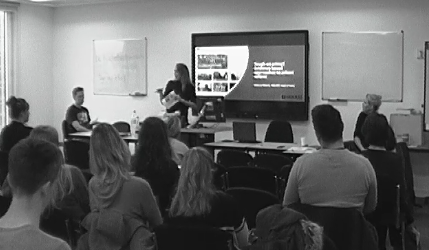
Ms Roberts primarily addressed the work of INQUEST. INQUEST came about out of campaigns in the 1980’s around State deaths in lots of different incarceration settings (eg prisons, mental hospitals, police cells, etc). Issues of State denial, blaming the victims, inequality of resources and State abandonment inspired the formation of INQUEST. Its aims are to end deaths in detention, end institutional discrimination, and give families access to justice through advice, empowerment and support.
INQUEST sets out to humanise, rather than dehumanise, prisoners, and to contextualise, rather than simply individualise, deaths in custody. INQUEST seeks to make the invisible visible, and empower those who have been affected by the prison system. Bereaved families are the central focus for the charity, and while the State has cultivated ‘tough prison conditions’, INQUEST attempts to work with prisoners and families to make positive changes ‘in spite of the prison system’.
Its position on prisons is abolitionist. Prisons are ‘dumping grounds’ for people with problems, and the function of prisons has always been this. The prison system creates all kinds of problems: a disjuncture between what happens behind closed doors and what the public hears about, it causes repercussions at an individual, institutional and systemic level, there are almost always unintended consequences from new policies, and reforms are almost always ‘sucked back’ into the pro-prison mentality. For example, interventions by the State to criminalise activities tends to corrupt or co-opt community organisations into the ‘prison narrative’, especially those dependent on government funding.
INQUEST collates findings, data and decisions regarding deaths in custody, like suicide levels and ‘death by natural causes’ (eg from diabetes, asthma, TB) which are often premature. Ms Roberts illustrated an extreme case of death by ‘natural causes’, that of a 19-year-old, first time offender, who was an inmate at Doncaster. The young man’s conditions began to deteriorate in prison; he was unable to feed himself, and was left in his cell by prison staff covered in his own faeces for a whole day. Finally prison staff realised he was extremely dehydrated, and a GP was called, who found him to be seriously ill. He was rushed to hospital and put into an induced coma, later dying from meningitis. Although INQUEST hopes the prison authorities will learn from deaths in custody, recent publications like ‘Still Dying on the Inside’, show how little has changed to improve prison conditions.
Ms Roberts presented INQUEST’s recommendations on prisons, which included: halting prison building, improving standards in prison, legal aid for in-prison representation, and prison as a ‘measure of last resort’.
Panel Discussion: Post-Custody Deaths, Treatment Programmes, Change
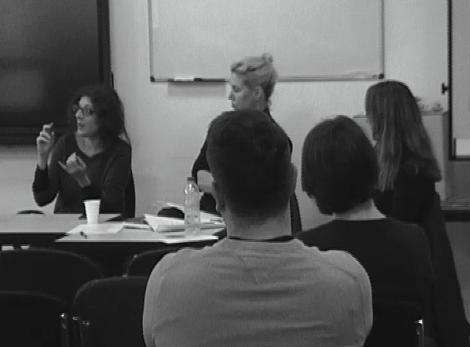
The guest panel took questions from the MC and the audience, the discussion touching on post-custody deaths, the maintenance of innocence and anti-prison activism.
Deaths of prisoners post-custody has been recently been put in the spotlight by worrying statistics. While deaths in prison are on average one person every four days, those post-custody rise to one every two days (a five-fold increase from the period before). This relates to all kinds of issues post-custody such as finding accommodation and support in the community. It is a grey area in terms of monitoring, and it needs to be better scrutinised. It is also another example that the harm caused by prison ‘follows you out of prison’. Another issue requiring ‘urgent investigation’ is Release Under Investigation (“RUI”) and its effects.
Prisoners are expected to attend courses in prison, and acknowledge their guilt, to secure parole and release. However, issues have been raised about treatment courses, for example Sex Offenders Treatment which has been found to be ‘ineffective’ and ‘more dangerous’ by having several offenders together discussing their fantasies. The Ministry of Justice sat on a report disclosing this evidence for some time before releasing it. Books like ‘Bad Psychology: How Forensic Psychology Left Science Behind’ illustrates the misuse of forensic psychology in prisoner assessments. While there is no evidence that those who are remorseful have a lower risk of re-offending, nevertheless, it is often a weighty factor in deciding whether to grant parole or not (however, the Parole Board cannot reject an application for parole for this reason alone).
Prison reform is a topic which is a ‘vote loser’ for politicians, and therefore it is rarely addressed. To bring about change, it’s about ‘being crafty’ – going round the State and politicians, and instead changing people on the ground. Looking at the history of prison abolitionist movements in the UK, particularly the 1960’s, these ideas were centred in the academic community. What we need to do is involve grass-roots communities, like those affected by over-policing. Having conversations with people will ‘slowly, slowly’ raise awareness amongst the public. It is important to get ‘out of the bubble’, and have a ‘political life’ in the wider community, engaging not just those who agree with prison reform, nor just those directly affected by prisons, but everyone.
LUNCH: With the end of the first workshops, a ‘sandwich-lunch’ was served up by ‘Share Community’, a charity providing work for disabled adults. The second workshop followed, attending as I did, ‘(Un)Intentionally Homeless’.
WORKSHOP 2: (UN)INTENTIONALLY HOMELESS: CHALLENGING UNFAIR HOUSING DECISIONS
Speakers:
- Connor Johnston – Garden Court Chambers (barrister)
- Simon Mullings – Edwards Duthie Shamash (solicitor)
- Jo Underwood – Shelter (charity)
- Izzy Koksal – Housing Action Southwark and Lambeth (HASL) (activist)
Connor Johnston –Homelessness Law in 3 Minutes
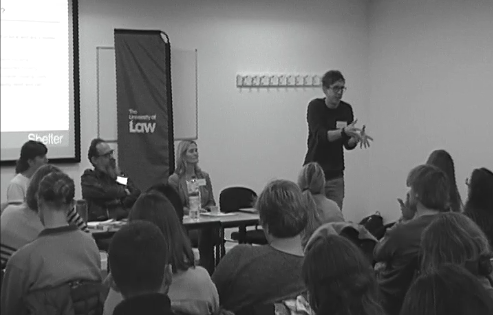
Connor provided a whistle-stop introduction to homeless law for the audience, a timed three-minute presentation using that barrister’s trusty friend – a stop-watch.
There is essentially one piece of legislation dealing with homelessness, namely the Housing Act 1996, in particular Part 6. The law relating to social housing waiting lists is separate, under Part 7. The law, and enforceable rights, relating to housing has changed little since 1977.
In order to make an application for homelessness, the first step is to make an application at the local authority’s offices. Once accepted, the application will be assessed using four criteria:
- Homeless? The test for whether someone is homeless the person must not have accommodation ‘which it would be reasonable for him to occupy’ (HA 1996, s175(3));
- Eligible? This primarily relates to the status of the individual applying, particularly their immigration status;
- Priority Need? This relates to characteristics which are prioritised for social housing provision, such as pregnant women and ‘vulnerable’ adults (the former term is a highly litigated area and the legal test now has a high threshold); and,
- Intentionally Homeless? Whether it was the person’s own fault that they are now homeless.
If the person applying meets all the tests, they are ‘actually eligible’, which means that the local authority has a ‘housing duty’ to the individual. However the authority can offer the applicant accommodation outside the borough, which they cannot refuse without jeopardising the duty owed them. The only way to challenge the decision is by way of a review.
Jo Underwood – Homelessness in the UK
Jo gave us an introduction to the history of homeless campaigning in the UK, showing us the photographs of Nick Hedges depicting slum conditions in Liverpool in 1964. His pictures inspired further campaigning on housing, such as Ken Loach’s seminal film on homelessness, ‘Cathy Come Home’. She then showed us contemporary photographs, taken in 2014, of families living in temporary accommodation. The cramped conditions were evident in both sets of images. Statistics of homelessness in the UK for 2019 show that there are 84,000 families in temporary accommodation, including 126,000 children. The causes of homelessness have a number of trigger events, but the research consistently shows that homelessness is an issue of inequality; those on low incomes can’t compete with better off households for accommodation in many areas, leading to a crisis of affordability.
Izzy Koksal – The work of mutual-support groups
Izzy set out the work HASL does in the boroughs of Southwark and Lambeth. HASL is not a charity, but a group of volunteers with housing issues, who have ‘agency’ and work together to build solidarity. Because it is not a charity, the group can be outspoken on issues. Housing is the ‘basis of everything’. Once a person has secure accommodation, they can move on to start looking for work and ‘getting on with the rest of life’. The group work on the principle that just because they are homeless, they are not helpless. The group runs a ‘buddy’ system for those attending interviews at the local authority’s offices, it works with lawyers, runs campaigns and holds protests.
The group hold regular meetings, attended by 50+ people at a time, mostly women and children. For many in the group, English is not their first language, and children often act as translators for their parents. In the group, people learn about their rights, talk about their housing problems, share their experiences and give one another moral support. HASL helps people prepare for suitability reviews, records communication with the council, and advises members on their decisions, such as never to refuse any accommodation offered by the council. HASL members ‘buddy’ one another when attending meetings with the council. In one case, a buddy constantly tweeted all day about how the meeting was going, so that eventually the council offered the person temporary accommodation instead of a decision of ‘intentionally homeless’.
HASL helps its members to access justice. One of the legal cases HASL has been involved with was a housing appeal by a woman who had been a victim of domestic violence for over 30 years. The woman sought to get secure council housing following her ordeal, but the local authority refused to accept that she was ‘vulnerable’. The lady started campaigning vigorously, and eventually won her case against the local authority, and through her work, helped secure accommodation for three other women in a similar situation. Another legal means to challenge local authorities is approaching the local government ombudsman in cases where ‘turpitude’ (Collins: ‘base character or action; depravity’) has occurred, and compensation is sought. The introduction of the Homelessness Reduction Act 2017, a bill sponsored by the housing charity Crisis, has not helped matters. The new law now makes it even harder to learn your rights, because the legislation is complicated, and thus disempowering.
HASL campaigns against ‘bad housing decisions’. In HASL’s experience, the concept of ‘intentionally homeless’ is a ‘racist’ concept, especially for migrant families. The local authority will often refuse to house these families because they left their previous homes voluntarily to come to London. These decisions have an impact on people’s lives, so that once someone has been branded ‘intentionally homeless’ it is hard to shake. The energy and effort required to fight such decisions takes an emotional toll. The council’s approach to these decisions highlights a power imbalance between local authorities and residents. The local authority is able to say what it wants. Izzy gave an example of a tenant who complained of overcrowding to Southwark Council, who told him to stop complaining and ‘look on Zoopla.com’. Throughout, Izzy came back to the question: ‘What is its purpose (the label ‘intentionally homeless‘)? What does it mean?
HASL assists in protest actions. In one case, members of the group, housed in ‘stressful’ temporary accommodation outside the borough, went down to protest at the council offices and town hall. The members at the protest decided to escalate the action, mobbing the council’s housing director with their demands. As a result, those affected were relocated back into the borough.
Simon Mullings – the UK government’s (unwritten) housing policy
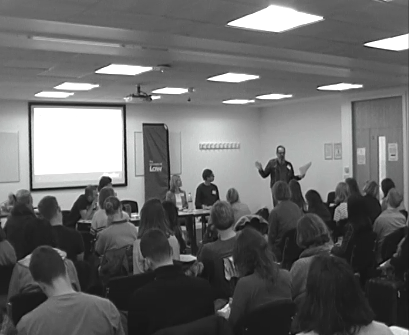
Simon moved onto a brief history of the UK government’s housing policies since 1977. By examining the Parliamentary debates on the original Housing Act 1977 in Hansard, the concept of ‘intentionally homelessness’ was intended to stop those who ‘buck the system’, by using homelessness as a means to get to the top of the housing ladder.
In the Housing Act 1980 ‘right-to-buy’ (or the ability of council tenants to buy their properties) was introduced. Following this, over 2 million social housing units were sold into the private market, so that around 1/3 of these homes are now let out by the Private Rented Sector (“PRS”). The policy of ‘right-to-buy’ was a massive ‘state-instigated asset strip’, with housing benefit payments used to subsidise private landlords on a large scale (eg Charles Gow). To add insult to injury, the money raised from ‘right-to-buy’ sales was excluded from funds that could be used by the local authority to build additional council homes. In 1986, Assured Shorthold Tenancies (“AST”) were introduced, tenancies which provided no security of tenure. It became the main vehicle by which local authorities could discharge their housing duties. Once more, ‘the poison was administered as the cure’.
The unwritten principle behind these policies is the ‘scarcity principle’, or by restricting supply, prices rise. The government’s policies since 1977 are a ‘conspiracy to create homelessness’ – their purpose twofold. First it allows PRS landlords to increase rents without rent controls, the second being the image of street homelessness as an ‘advertisement’ of the alternative, driving fear into the hearts of those paying high rents. Homelessness has been created by the State – it is not a mistake. If the local authority or government has the will to change it, it also has the means. In Wales, there are two pieces of legislation passing through the Welsh Assembly which aim to reverse harmful policies. The first is the abolition of ‘right-to-buy’ in Wales, and the second, the abolition of ‘intentional homelessness’ for women and children.
Connor Johnston – Challenges in housing Law
Connor ran us through a case he is currently working on, an appeal of Tower Hamlets LBC v Al Ahmed [2019] EWHC 749 (QB). The case deals with late appeals, which should be lodged within 21 days following the court decision. Late appeals are allowed out of time if there is a ‘good reason’ and the applicant has not delayed. In this case, Al Ahmed couldn’t find a lawyer because he was homeless, and by the time the charity helping him located one, the appeal was already 1 month late. The County Court judge accepted Al Ahmed’s circumstances as a ‘good reason’ because he was ‘vulnerable’ and did not delay, but its decision was overturned in the High Court. The case is listed to appear before the Court of Appeal in January 2020.
The changes to the CPR in 2013 have been interpreted by the courts in a way which is ‘tough and harsh’. The homeless face many barriers accessing justice, such as lack of access to the internet and a stable home life. Counsel for the appellant will need to get across to the Court of Appeal ‘what it is like being homeless’, which will include evidence from Shelter, the housing charity.
Jo Underwood – Strategic litigation & co-operation
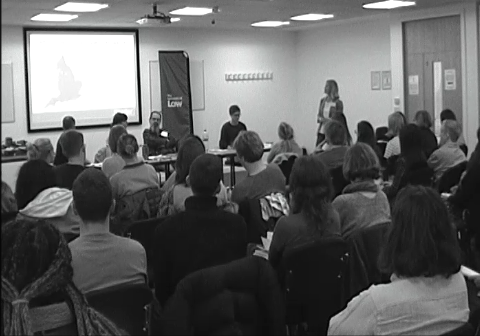
Jo covered the case of Samuels v Birmingham City Council [2019] UKSC 28, an example of Shelter’s commitment to strategic litigation in housing cases. The case centres on the Local Housing Allowance (“LHA”) freeze and housing benefit claimants having to use their ‘subsistence’ payments to top up rent payments (see my previous article – ‘Talking Strategic Litigation at Doughty Street Chambers’). As a result of rent arrears caused by the shortfall, Samuels was deemed ‘intentionally homeless’. The case went all the way to the Supreme Court, which found that benefit claimants should not have to dip into their other welfare benefits to pay their rent. The litigation was brought by assembling a team around the case, including lawyers, community groups, campaigns and artists.

James AC MacDonald is a recent graduate from City Law School, having completed his BPTC LLM there in 2019. His legal interests are centred on housing and environmental law. Follow him on his journey through the law on Twitter at: @ac_macdonald.
